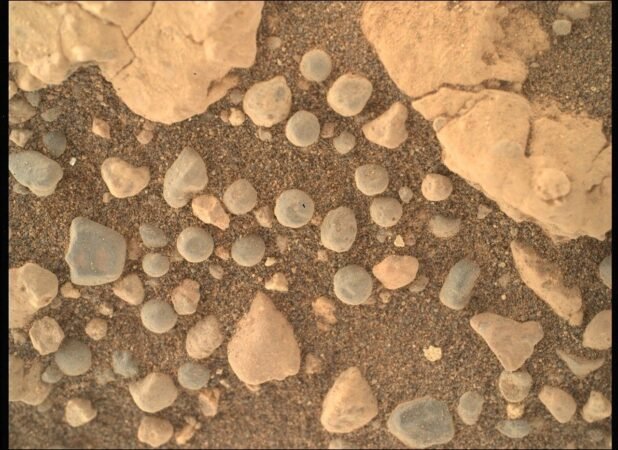Summary Points
-
Discovery of Spherules: The Perseverance rover has encountered distinct spherules at “Rowsell Hill,” contrasting its earlier findings of hematite spherules (“blueberries”) by the Opportunity rover.
-
Different Origins: The spherules at Rowsell Hill have a basaltic composition, likely formed from either meteoroid impacts or volcanic eruptions, differentiating them from the groundwater-saturated hematite spherules of Meridiani Planum.
-
Advanced Analysis Tools: Utilizing instruments like SHERLOC and PIXL, Perseverance captured high-resolution images and conducted elemental analysis of the spherules and surrounding regolith.
- Scientific Implications: Understanding the origins of these new spherules can provide insights into ancient impacts or volcanism on Mars, shedding light on the planet’s dynamic history.
NASA’s Perseverance Rover Studies Martian Spheres
NASA’s Perseverance rover continues to unveil the mysteries of Mars. Recently, it identified nearly perfect spheres in the soil at "Rowsell Hill." This discovery echoes the earlier findings of Opportunity, which uncovered hematite spherules, affectionately called “blueberries.” However, the recent findings yield new insights into Martian history.
On July 4, while celebrations lit up the skies on Earth, Perseverance focused on analyzing the regolith rich in spherules. The rover’s advanced instruments, including SHERLOC and PIXL, captured high-resolution images and measured the elemental composition of these intriguing formations.
Interestingly, the new spherules differ significantly from their predecessors. Opportunity’s “blueberries” formed in groundwater-rich sediments, while Perseverance’s spheres likely emerged from meteoroid impacts or volcanic activity. When meteoroids strike Mars, they can melt rock and create droplets that cool into spherules. Alternatively, volcanic eruptions could produce similar formations from molten lava.
Understanding the origins of these spherules is crucial. If they stem from an ancient impact, they might provide insights into the types of meteoroids that struck Mars. Conversely, if they result from volcanic activity, they could reveal valuable information about the region’s volcanic history.
These findings not only enhance our comprehension of Mars but also have practical implications for technology development. Advancements in robotic systems and sensors facilitate these vital studies, paving the way for future exploration. As scientists continue to probe these Martian spheres, they hold the promise of illuminating the planet’s dynamic past and its evolution over billions of years.
Expand Your Tech Knowledge
Learn how the Internet of Things (IoT) is transforming everyday life.
Stay inspired by the vast knowledge available on Wikipedia.
SciV1

